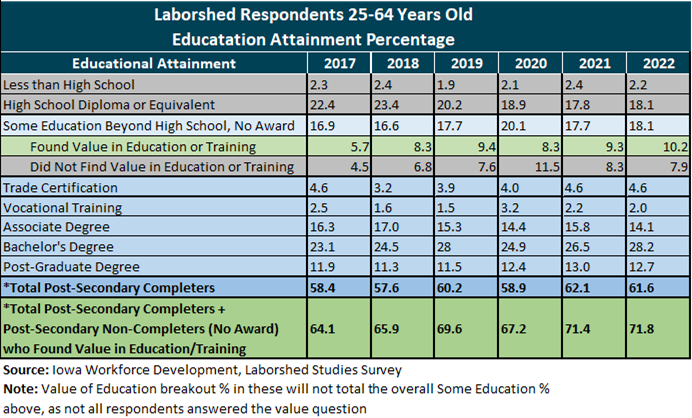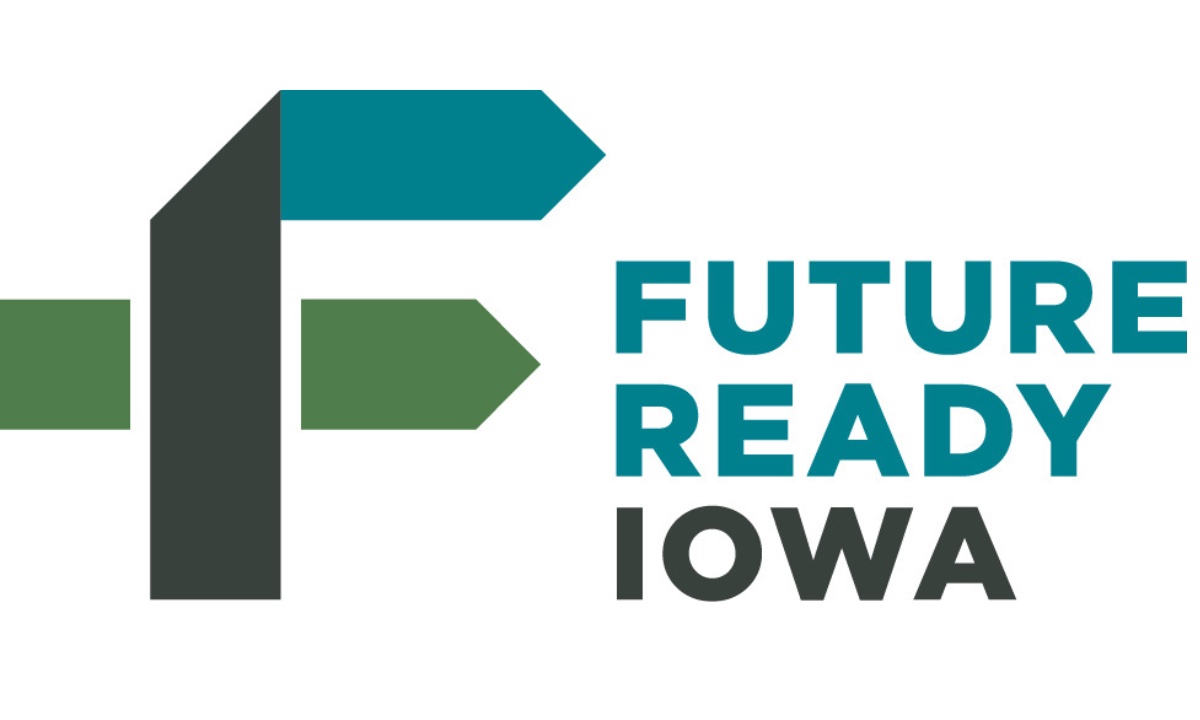Tom Walton chairs the Dallas County Democrats.
In 2018, Governor Kim Reynolds made “Future Ready Iowa” her trademark program designed to improve Iowa’s workforce, setting a goal to increase the number of Iowans who had attained a post-secondary education to 70 percent of the workforce by 2025.
Reynolds announced in last month’s Condition of the State address, “I’m happy to say that we’ve reached our ambitious goal, and we did it ahead of schedule.” Future Ready Iowa’s website likewise asserts, “we are now proud to report that we have met that goal as a state.”
Two years ahead of schedule sounds like a huge public policy accomplishment, right? Not so fast. On closer examination, Reynolds and her team fudged the numbers.
THE INITIAL GOAL: 70 PERCENT HOLDING POST-SECONDARY DEGREES
The Future Ready Iowa Alliance (led by the governor’s office) recognized Iowa’s workforce crisis in a 2017 report called Metrics That Matter. There were not enough skilled workers to fill the jobs of the future. The Lumina Foundation, which supported the report, had set a goal of 60 percent of Americans “holding degrees, certificates or other postsecondary credentials by 2025.” (emphasis added).
Similarly, Iowa set the goal of 70 percent of Iowa’s workforce ages 25 to 64 having education beyond high school by 2025. The report stated: “This will mean more Iowans will have rewarding careers in high-demand fields, and that employers will be able to hire the skilled workers they need.” At the time, the report cited government reports showing the percentage of Iowans with post-secondary certificates or degrees was only 58 percent.
The objective was clear: ”[T]o reach the 70 percent goal . . . Iowa needs an additional 127,700 residents to earn postsecondary degrees and other credentials by 2025.”
The measure used to determine progress toward that goal was clearly stated as “postsecondary educational attainment. . . meaning Iowans who have completed two-or four-year college degrees as well as other credentials, such as trade certifications and other vocational training.”
Therefore, the goal was completion of a post-secondary degree, certification licensure or apprenticeship program, not just taking a few classes after high school that a person thought might be helpful.
The metrics chosen to measure Future Ready Iowa’s progress confirmed the intention. The program adopted the data provided by the Iowa Workforce Development’s Laborshed Survey, and in particular, the survey’s reported percentage of “total completers beyond high school.” The 2016 report showed the total percentage of “completers” had grown from 48.3 percent in 2008 to 58.1 percent in 2016.
Thereafter, annual Future Ready Iowa reports repeated the same 70 percent goal using the same survey benchmark of “total completers beyond high school” to measure progress of the program. For example, in her cover letter to the 2019 program report, Reynolds stated: “Our challenge together is mobilizing Iowans to earn an additional 139,900 postsecondary credentials by 2025.”
There was just one problem: the 2018 labor survey indicated that the “total completers” percentage had fallen since the program started, from 58.4 percent to 57.6 percent.
EARLY SIGNS OF “LITTLE PROGRESS TOWARD OUR STATE’S GOAL”
From the beginning, some questioned whether Future Ready Iowa could meet its goal of 70 percent post-secondary “completers.” The 2018 Condition of Higher Education in Iowa report, published by Iowa College Aid, warned about the program’s inadequacies: “Overall, small increases in attainment and growing gaps in achievement suggest little progress toward our state’s goal that 70 percent of Iowans have education or training beyond high school by 2025.”
Speaking to the Des Moines Register at the time, Iowa College Aid’s spokesperson Elizabeth Keest Sedrel said, “We need to accelerate what we’re doing, and we particularly need to target the populations where we see the biggest gaps — Hispanic students, black students, low-income students.” Furthermore,
“A lot of minority and low-income students are lagging in college readiness and completion,” said Mark Wiederspan, executive research officer at the state agency [Iowa College Aid]. “This is particularly troublesome because (they) are part of the growing population segments of our state.”
Iowa’s 2022 labor survey showed the percentage of post-secondary completers had fallen again, from 62.1 percent in 2021 to 61.6 percent in 2022.

Since Future Ready Iowa’s inception, the percentage of post-secondary completers had increased by only about 3 percent.
It would need to triple that growth in the remaining two years to meet the goal of 70 percent by 2025. Something had to be done.
MOVING FUTURE READY IOWA’S GOALPOSTS
In response, the Reynolds administration moved the goalposts, changing both the program’s objective and the metric used to measure it.
Remember, Reynolds declared victory in her 2024 Condition of the State address: “Tonight, I’m happy to say that we’ve reached our ambitious goal, and we did it ahead of schedule. […] reaching this milestone serves as a powerful lesson in how real change happens.”
That would be great, if true. But it is not.
The original goal was 70 percent of Iowans having training or education beyond high school. But seven years into the Future Ready Iowa program, the Reynolds administration changed the goal from the completion of a post-secondary educational program to having obtained “some form of post-high school education or training.”
Then, they changed the measure of success. Rather than using the percentage of completers—which in 2022 was 61.6 percent, or 8.4 percent short of the target for 2025—the administration, again for the first time, used as its measure of success the “total post-secondary completers” plus “post-secondary non-completers (no award) who found value in education/training.”
Fortunately for Reynolds’ team, the 2022 Laborshed survey put that total at 71.8 percent.
The truth is the Future Ready Iowa program has not met and will not meet its target of having 70 percent of Iowans between the ages of 25 to 64 complete a post-high school educational program by 2025.
Does it matter? When the program launched in 2017, the Metrics That Matter report stated, “It is impossible to overstate the importance of reaching this goal.” It further warned, “without a significant enhancement to our state’s workforce education and training our competitiveness could evaporate,” and “solving Iowa’s workforce crisis is an economic imperative.”
Those high stakes may explain why the Reynolds administration manipulated the program’s goal and benchmarks. Such misleading conduct undermines the public faith in government and other efforts to improve Iowa’s workforce.
The governor should not avoid accountability for her administration’s crude effort to gloss over Future Ready Iowa’s failure to achieve its primary goal.


6 Comments
Wow, that PR maneuver took an impressive amount of gall...
…but gall is one thing that Kim Reynolds has never lacked. Thank you, Tom Walton.
And thank you, CEDAR RAPIDS GAZETTE, for reporting the arrival in Iowa of a new “nonpartisan” (hahaha) think tank called the Common Sense Institute, which is described by some detractors as follows: “the organization’s research is driven ideologically toward a certain conclusion, then works backward for the desired results.” Sounds like the CSI will be very helpful to the Governor’s Office, not to mention Iowa Republican candidates! Here’s a telling look at CSI work in Colorado.
https://www.westword.com/news/common-sense-institute-colorado-think-tank-13277925
I’ve seen no coverage of the Common Sense Institute in the DM REGISTER
PrairieFan Mon 5 Feb 10:45 PM
The help Iowans don’t need
The author rightly notes an exaggeration of Governor Reynolds. As an official of a local Iowa Democratic party, the author probably remembers which party fought for closing schools during Covid, which party fights for dumbing down instruction so that everyone gets empty diplomas and feels welcome (in theory). With politics of both sides weakening our schools, it’s no wonder that young educated Iowans are voting with their feet and moving out of State.
Karl M Tue 6 Feb 11:30 AM
Infallible Leader Syndrome?
Stuff like this is par for the course with this crowd.
Move the goal posts, change the rules, make shit up, lie.
Nice work Tom to expose this clear attempt to misinform the public.
Why did the governor choose to do this? Most everyone understands that decisions around committing to school or training programs were impacted by the pandemic.
Robert Kennedy once said of Lyndon Johnson . . . “he lies even when he doesn’t have to.”
Kind of fits here, you think?
Bill Bumgarner Tue 6 Feb 11:49 AM
indeed Bill this is who they are
and everything thing they do/say should be understood as more of the same. So we should learn from history and not trust but verify what they do, can we?
dirkiniowacity Tue 6 Feb 12:16 PM
The help Iowans don't need
Karl M: Your comment that “the politics of both parties weaken schools” is absurd.
Rod Sullivan Wed 7 Feb 7:19 PM
Yes but
Yes Mr. Sullivan. My finding is absurd, but sadly true.
Karl M Fri 9 Feb 7:30 AM